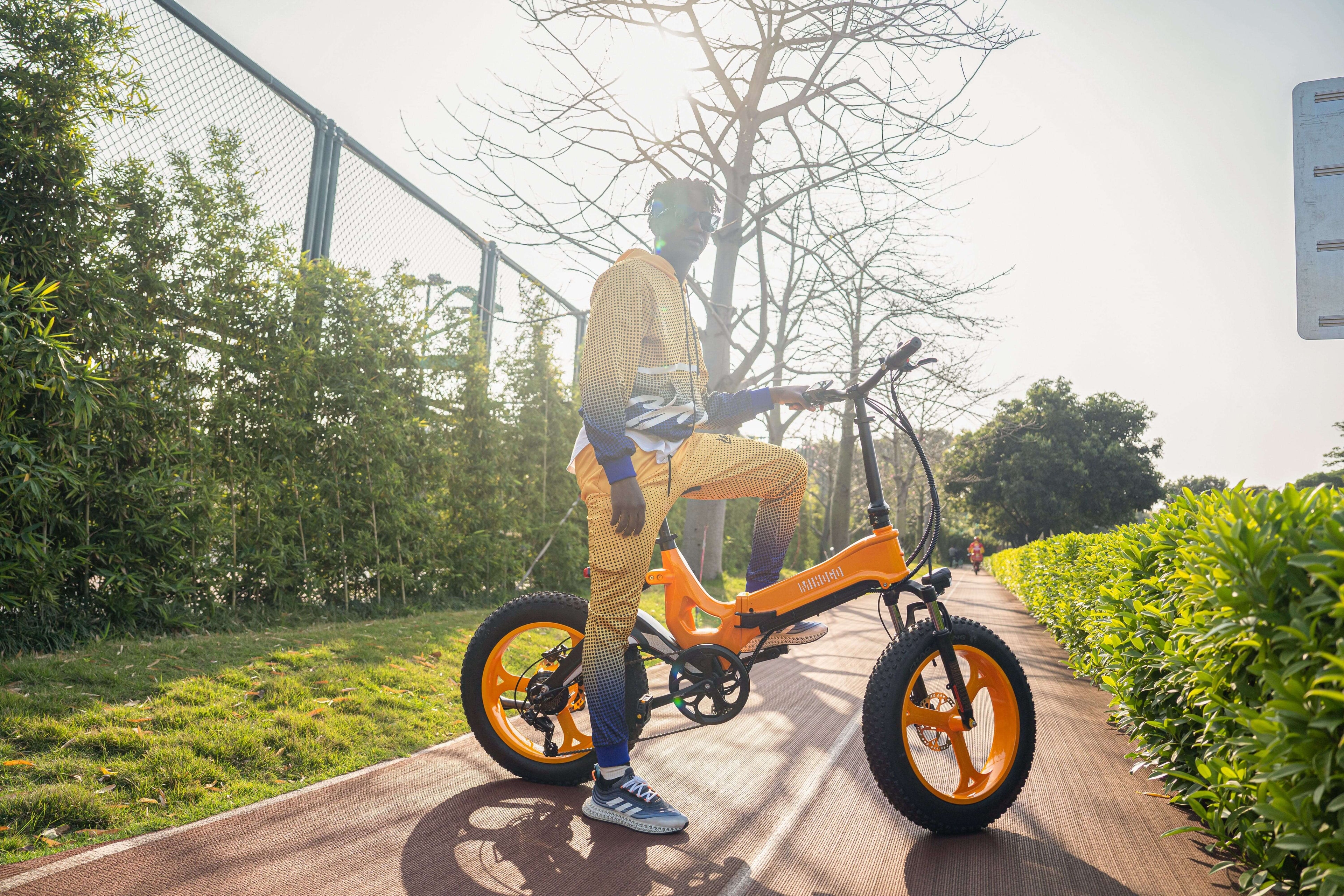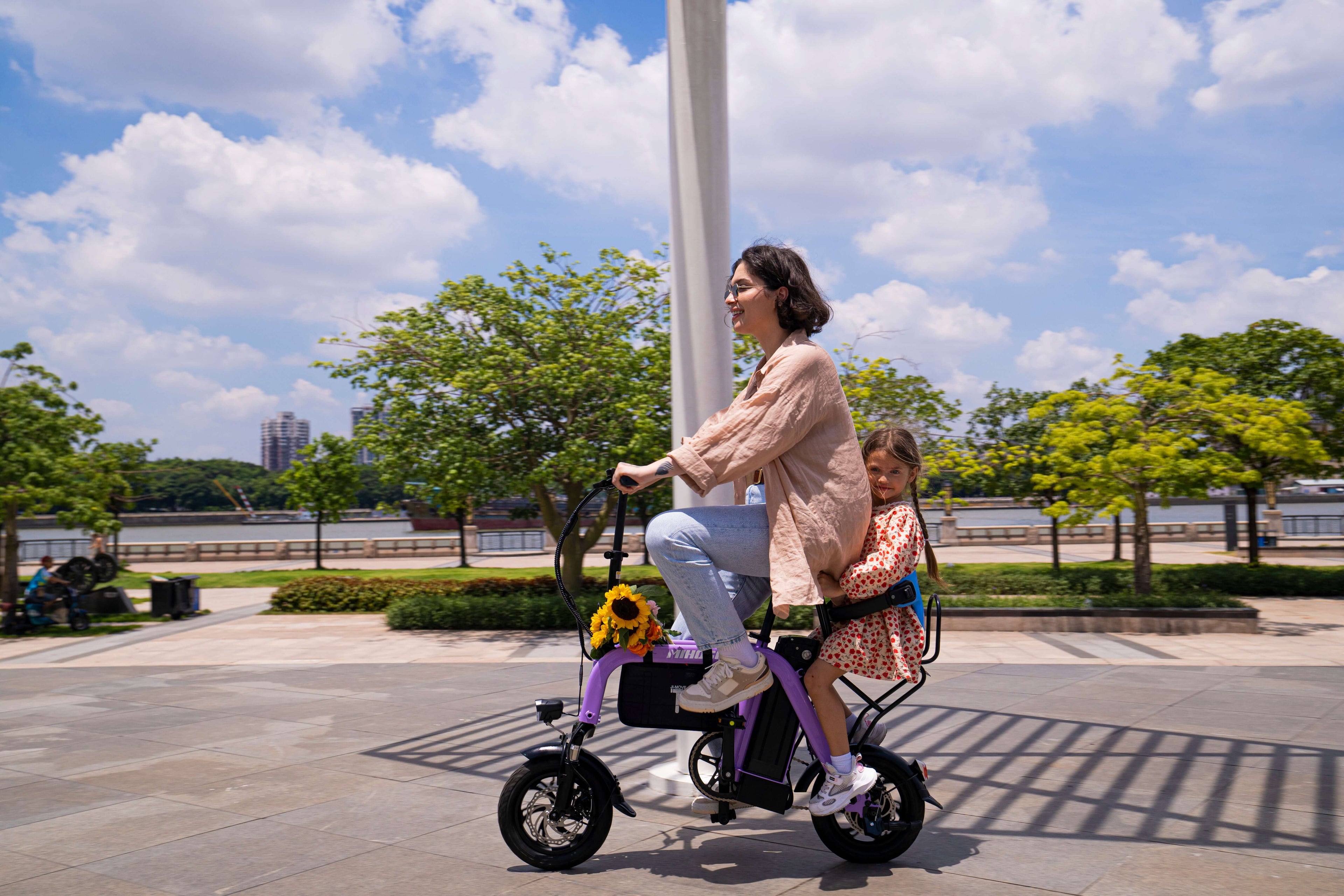With 2025 bringing advanced sensor technologies and more sophisticated diagnostic capabilities, mastering sensor troubleshooting becomes essential for maximizing your Mihogo's performance and safety. Whether you're riding the powerful Air750 Max with its 750W system, the utility-focused ONE with 167-mile range, the compact RX 2.4 folding commuter, or the efficient Mini, proper sensor diagnostics ensure your investment delivers consistent, reliable performance.
Understanding Mihogo E-Bike Sensor Systems
Modern Mihogo e-bikes integrate multiple sensor types working harmoniously to deliver intuitive, responsive power assistance. Each sensor serves a specific function in the overall system, and understanding their roles helps identify problems when they arise.
Essential Sensor Types in Mihogo E-Bikes
Speed Sensors The speed sensor is fundamental for regulating your Mihogo's motor assistance and ensuring compliance with speed limits. Located either in the rear hub (on hub motor models) or attached to the chainstay with spoke magnets, speed sensors detect wheel rotation and communicate this data to the motor controller.
Cadence Sensors (Pedal Assist Sensors) Cadence sensors detect when you begin pedaling and measure pedaling frequency. These sensors enable the pedal-assist functionality that makes Mihogo e-bikes so efficient for commuting and recreational riding.
Torque Sensors (Advanced Models) Higher-end Mihogo configurations may include torque sensors that measure the actual force applied to the pedals. This technology provides more natural, responsive power delivery that matches your pedaling effort.
Brake Sensors Critical safety components, brake sensors automatically cut motor power when brakes are applied, ensuring smooth deceleration and preventing dangerous situations where the motor continues pushing while you're trying to stop.
Hall Sensors (Motor Position Sensors) Internal to the motor, Hall sensors detect rotor position and enable precise motor control. These sensors are essential for smooth motor operation and efficient power delivery.
Model-Specific Sensor Configurations
Mihogo Air750 Max - Premium Sensor Integration
The Air750 Max's 750W motor system incorporates sophisticated sensor integration optimized for high-performance riding:
Advanced Speed Sensing: High-precision speed sensors maintain accurate readings even at the 25 mph top speed, ensuring consistent performance throughout the speed range.
Power Management Sensors: Temperature and current sensors protect the high-output motor during sustained high-power operation.
Range Optimization Sensors: Battery management sensors work with the 121-mile range system to provide accurate range estimates and optimal power delivery.
MIHOGO ONE Utility - Heavy-Duty Sensor Systems
The ONE Utility's 750W motor designed for work applications requires robust sensor systems:
Load-Responsive Sensors: Enhanced torque sensing capabilities adapt to varying cargo loads while maintaining smooth power delivery.
Extended Range Sensors: Sophisticated battery monitoring supports the impressive 167-mile range with accurate remaining capacity calculations.
Durability-Enhanced Sensors: Industrial-grade sensor protection for demanding utility applications and frequent start-stop cycles.
MIHOGO RX 2.4 - Compact Commuter Sensors
The RX 2.4's 500W folding design incorporates space-efficient sensor solutions:
Compact Speed Sensors: Miniaturized sensor systems that maintain accuracy despite the folding frame design.
Commuter-Optimized Sensors: Calibrated for frequent acceleration and deceleration cycles typical in urban commuting.
Quick-Response Sensors: Fast sensor response times for immediate power delivery in traffic situations.
Mihogo Mini - Efficient Urban Sensors
The Mini's 350W motor uses precision sensors maximizing efficiency in compact packaging:
High-Efficiency Sensors: Ultra-low power consumption sensors that don't impact the 62-mile range.
Urban-Tuned Sensors: Optimized for stop-and-go city riding with responsive power modulation.
Lightweight Integration: Minimal sensor weight impact on the compact design philosophy.
Common Sensor Problems and Symptoms
Speed Sensor Malfunctions
Speed sensor problems often present clear indicators that experienced Mihogo riders learn to recognize quickly.
Erratic Speed Readings When speed sensors malfunction, your Mihogo's display may show fluctuating or incorrect speed readings. This creates difficulty maintaining steady pace and can affect range calculations.
Inconsistent Motor Assistance A malfunctioning speed sensor can cause the motor to provide assistance intermittently or cut out unexpectedly, creating the sensation that your Mihogo suddenly becomes much heavier.
Error Code Display Your Mihogo's display may show specific error codes related to motor or controller communication, indicating speed sensor issues requiring attention.
Delayed Throttle Response If your Mihogo includes throttle functionality, sensor problems can cause delayed or jerky response, indicating disrupted signal flow.
Cadence Sensor Issues
No Pedal Assist Activation The most obvious symptom of cadence sensor failure is complete lack of motor assistance when pedaling, even though the battery shows adequate charge.
Delayed Assist Engagement Functional but degraded cadence sensors may cause noticeable delays between starting to pedal and motor engagement, disrupting smooth riding flow.
Assistance Cutting Out During Riding Intermittent cadence sensor problems cause motor assistance to stop unexpectedly during rides, particularly noticeable during climbs or acceleration.
Inconsistent Power Levels Faulty cadence sensors can cause power delivery to vary unpredictably, making it difficult to maintain consistent speeds or manage battery consumption effectively.
Torque Sensor Problems (Advanced Models)
Unnatural Power Delivery Malfunctioning torque sensors create artificial, non-intuitive power assistance that doesn't match your pedaling effort, disrupting the natural riding feel.
Power Surges or Drops Defective torque sensors can cause sudden power increases or decreases unrelated to your pedaling force, creating unpredictable and potentially unsafe riding conditions.
Calibration Drift Over time, torque sensors may lose calibration, resulting in either insufficient assistance requiring more effort than expected, or excessive assistance that feels overpowering.
Brake Sensor Malfunctions
Motor Continues During Braking The most dangerous brake sensor problem is motor assistance continuing even when brakes are applied, creating potentially hazardous situations requiring immediate attention.
Motor Won't Engage Conversely, stuck brake sensors can prevent motor engagement entirely, as the system believes brakes are constantly applied.
Intermittent Brake Sensor Activation Faulty brake sensors may trigger randomly, causing sudden, unexpected motor cutoffs during normal riding.
Systematic Diagnostic Procedures
Initial Visual Inspection Protocol
Step 1: Safety First Before beginning any diagnostic work, ensure your Mihogo is powered off and securely positioned. Remove the battery if possible to prevent accidental activation during inspection.
Step 2: Sensor Location Verification Identify all sensor locations on your specific Mihogo model:
- Speed sensors: Check rear wheel hub or chainstay mounting
- Cadence sensors: Examine bottom bracket and crankset area
- Brake sensors: Inspect brake lever assemblies
- Display connections: Verify handlebar-mounted display connections
Step 3: Physical Damage Assessment Carefully examine each sensor for:
- Cracked or damaged sensor housings
- Bent or displaced mounting brackets
- Corroded or loose electrical connections
- Missing or damaged magnetic components
Step 4: Cleanliness and Alignment Check Many sensor problems stem from dirt accumulation or misalignment:
- Clean sensor faces with appropriate cleaning solutions
- Verify proper gap distances between sensors and trigger elements
- Check magnet positions and security
- Ensure no debris interferes with sensor operation
Advanced Electrical Diagnostics
Multimeter Testing Procedures For Mihogo owners comfortable with electrical testing, multimeter diagnostics can identify specific sensor failures:
Continuity Testing: Verify electrical pathways remain intact through sensor wiring harnesses.
Voltage Testing: Check sensor power supplies and signal outputs during operation.
Resistance Testing: Measure sensor coil resistance values against manufacturer specifications.
Signal Testing: Monitor sensor output signals during simulated operation.
Software-Based Diagnostics
Error Code Analysis Your Mihogo's display system provides valuable diagnostic information through error codes. While specific codes vary by model and motor system, common categories include:
Motor Communication Errors: Indicate problems between controller and motor sensors.
Sensor Signal Errors: Point to specific sensor malfunctions or wiring issues.
System Configuration Errors: Suggest calibration or software problems requiring professional attention.
Battery Communication Errors: May indicate sensor problems affecting battery management systems.
Digital Multimeter Testing provides the foundation for advanced sensor diagnostics, enabling precise measurement of electrical parameters essential for accurate troubleshooting.
Model-Specific Troubleshooting Guides
Mihogo Air750 Max Sensor Diagnostics
High-Performance System Checks The Air750 Max's sophisticated sensor systems require specialized diagnostic approaches:
Temperature Sensor Verification: Monitor motor temperature sensors during sustained high-power operation to ensure proper thermal management.
High-Speed Sensor Accuracy: Test speed sensor accuracy across the full 0-25 mph range, paying special attention to consistency at higher speeds.
Power Delivery Smoothness: Evaluate sensor integration during maximum power output scenarios to identify performance degradation.
Range Calculation Accuracy: Verify that sensor inputs provide accurate range estimates matching real-world performance.
MIHOGO ONE Utility Diagnostic Procedures
Heavy-Load Testing Protocols The ONE Utility's work-focused design requires load-specific diagnostics:
Variable Load Sensor Response: Test sensor performance with different cargo configurations to ensure consistent operation under varying loads.
Extended Range Sensor Validation: Verify sensor accuracy during long-duration rides typical of utility applications.
Start-Stop Cycle Testing: Evaluate sensor performance during frequent acceleration and deceleration cycles common in delivery scenarios.
Environmental Durability Assessment: Check sensor performance after exposure to various weather conditions and work environments.
MIHOGO RX 2.4 Folding Mechanism Considerations
Folding-Specific Diagnostic Challenges The RX 2.4's folding design creates unique sensor considerations:
Folding Cycle Impact Testing: Verify that repeated folding and unfolding doesn't affect sensor calibration or mounting integrity.
Compact Component Access: Develop procedures for accessing sensors in the space-constrained folding design.
Transport Vibration Effects: Assess whether transportation vibration affects sensor alignment or connection security.
Quick Setup Verification: Ensure sensors provide immediate, accurate readings after unfolding and setup.
Mihogo Mini Urban Efficiency Diagnostics
Efficiency-Focused Testing The Mini's efficiency optimization requires specific diagnostic attention:
Low-Power Sensor Operation: Verify sensors operate correctly at the lower power levels typical of urban riding.
Frequent Stop-Start Response: Test sensor responsiveness during typical city riding patterns with frequent stops and starts.
Range Optimization Verification: Ensure sensor inputs support the Mini's 62-mile range optimization algorithms.
Compact Integration Assessment: Verify that space-efficient sensor integration doesn't compromise performance or reliability.
Professional Diagnostic Tools and Techniques
Mihogo-Compatible Diagnostic Equipment
Universal OBD-Style Diagnostic Tools Many modern e-bike systems support standardized diagnostic protocols similar to automotive OBD systems, enabling comprehensive system analysis.
Oscilloscope Analysis For advanced diagnostics, oscilloscopes can analyze sensor signal patterns and identify intermittent problems not detectable with basic multimeters.
Thermal Imaging Infrared cameras help identify overheating sensors or electrical connections that may indicate impending failures.
Vibration Analysis Specialized equipment can detect mechanical sensor problems through vibration pattern analysis during operation.
Software-Based Diagnostic Platforms
Manufacturer Diagnostic Software While Mihogo-specific diagnostic software may be limited, many motor manufacturers provide diagnostic tools compatible with their systems used in Mihogo e-bikes.
Generic E-Bike Diagnostic Apps Third-party smartphone applications can interface with many e-bike systems to provide basic diagnostic capabilities and error code interpretation.
Custom Diagnostic Protocols Advanced users may develop custom diagnostic procedures using programmable interfaces where available.
Repair and Replacement Procedures
DIY Sensor Repairs
Speed Sensor Maintenance Most speed sensor problems involve cleaning and realignment rather than replacement:
Cleaning Procedures: Use appropriate cleaning solvents to remove dirt and debris from sensor faces and magnetic trigger elements.
Alignment Adjustment: Carefully adjust sensor positioning to maintain proper gap distances specified in your Mihogo's service manual.
Magnet Replacement: Replace damaged or lost magnets with properly sized alternatives to restore sensor function.
Connection Maintenance: Clean and secure electrical connections to prevent intermittent operation.
Professional Sensor Services
When to Seek Professional Help Certain sensor problems require professional service capabilities:
Internal Motor Sensors: Hall sensor replacement typically requires motor disassembly and specialized tools.
Calibration Procedures: Complex sensor calibration may require manufacturer-specific software and procedures.
Warranty Considerations: Professional service maintains warranty coverage while ensuring proper repairs.
Safety-Critical Systems: Brake sensor problems should receive professional attention due to safety implications.
Replacement Parts and Compatibility
Genuine Mihogo Components Using authentic Mihogo replacement sensors ensures:
- Proper electrical compatibility
- Correct physical dimensions and mounting
- Maintained warranty coverage
- Optimal integration with existing systems
Aftermarket Alternatives When genuine parts aren't available, careful selection of compatible aftermarket sensors requires:
- Electrical specification matching
- Physical compatibility verification
- Integration testing before full installation
- Understanding of potential warranty implications
Preventive Maintenance for Sensor Longevity
Regular Maintenance Schedules
Monthly Sensor Inspections Establish routine monthly checks covering:
- Visual inspection for physical damage or contamination
- Electrical connection security verification
- Sensor alignment and gap distance confirmation
- Cleaning of sensor faces and trigger elements
Seasonal Maintenance Protocols Adjust maintenance intensity based on environmental conditions:
- Pre-winter preparation for cold weather operation
- Post-winter cleaning and calibration verification
- Summer heat monitoring for temperature-sensitive sensors
- Wet weather protection and moisture prevention
Usage-Based Maintenance Adapt maintenance frequency to riding patterns:
- High-mileage riders need more frequent sensor attention
- Utility applications require enhanced durability monitoring
- Recreational riders can follow standard maintenance intervals
- Harsh environment riders need increased protection measures
Environmental Protection Strategies
Weather Protection Implement strategies protecting sensors from environmental damage:
- Protective covers for exposed sensors during storage
- Regular cleaning after wet weather operation
- Corrosion prevention for electrical connections
- Temperature monitoring during extreme weather conditions
Storage Considerations Proper storage protects sensors during non-use periods:
- Climate-controlled storage when possible
- Battery removal to prevent electrical system drain
- Periodic activation to maintain sensor calibration
- Protection from physical damage during storage
Advanced Sensor Technologies and Future Trends
Emerging Sensor Technologies
AI-Enhanced Diagnostics Future Mihogo models may incorporate artificial intelligence for:
- Predictive sensor failure analysis
- Automated diagnostic procedures
- Self-healing sensor systems
- Enhanced user interface diagnostic guidance
Wireless Sensor Networks Advanced systems may utilize wireless sensor communication:
- Reduced wiring complexity and failure points
- Enhanced diagnostic data collection
- Remote monitoring capabilities
- Over-the-air calibration and updates
Integrated Health Monitoring Next-generation sensors may provide comprehensive system health data:
- Real-time performance optimization
- Predictive maintenance scheduling
- Component lifetime estimation
- Usage pattern analysis for optimization
Integration with Smart Infrastructure
Connected Diagnostic Systems Future sensor systems may integrate with:
- Smartphone applications for real-time monitoring
- Cloud-based diagnostic databases
- Remote technical support systems
- Sensor maintenance tracking for optimized service scheduling
Troubleshooting Decision Trees
Systematic Problem Resolution
Initial Symptom Assessment Begin troubleshooting with systematic symptom evaluation:
- Power-Related Issues: No motor assistance, intermittent power, or unexpected cutoffs
- Control Issues: Unresponsive controls, erratic behavior, or calibration problems
- Display Issues: Error codes, incorrect readings, or communication failures
- Safety Issues: Brake sensor problems or other safety-critical malfunctions
Progressive Diagnostic Approach Follow logical diagnostic progression:
Level 1: Basic visual inspection and cleaning procedures Level 2: Electrical connection verification and basic testing Level 3: Advanced electrical diagnostics and sensor testing Level 4: Professional diagnostic tools and software analysis
Cost-Benefit Analysis for Repairs
Repair vs. Replacement Decisions Consider multiple factors when deciding between repair and replacement:
Component Cost: Compare sensor replacement costs against repair labor System Age: Evaluate whether aging systems justify major sensor investments Performance Impact: Assess how sensor problems affect overall Mihogo performance Safety Considerations: Prioritize safety-critical sensor repairs regardless of cost
Professional Service Value Professional diagnostic services provide value through:
- Accurate problem identification reducing trial-and-error repairs
- Warranty-compliant repair procedures
- Access to specialized diagnostic equipment
- Comprehensive system testing after repairs
Error Code Reference Guide
Common Mihogo Error Codes
While specific error codes vary by motor system and model year, common categories include:
Speed Sensor Errors (E01-E05) Typically indicate speed sensor communication problems, misalignment, or electrical failures requiring basic troubleshooting procedures.
Motor Communication Errors (E10-E15) Point to communication problems between controller and motor, often involving multiple sensor systems requiring comprehensive diagnosis.
Battery System Errors (E20-E25) May indicate sensor problems affecting battery management, charging, or power delivery systems.
Brake System Errors (E30-E35) Critical safety-related errors requiring immediate attention and professional service for resolution.
Interpreting Error Code Patterns
Intermittent vs. Persistent Codes
- Intermittent codes often indicate connection or environmental problems
- Persistent codes typically require component replacement or professional calibration
- Pattern analysis helps identify root causes versus symptoms
Multiple Simultaneous Codes
- Multiple related codes may indicate single component failures affecting multiple systems
- Unrelated simultaneous codes suggest electrical system problems requiring comprehensive diagnosis
E-bike maintenance fundamentals provide the foundation for effective sensor care and optimal Mihogo performance throughout your ownership experience.
Safety Considerations and Best Practices
Electrical Safety Protocols
High-Voltage Safety While Mihogo e-bikes operate at relatively low voltages, proper safety procedures prevent accidents:
- Always disconnect power before sensor maintenance
- Use insulated tools for electrical work
- Avoid working on wet systems or in damp conditions
- Follow proper lockout/tagout procedures for battery systems
Component Handling Safety Protect sensitive sensor components during maintenance:
- Use anti-static procedures when handling electronic components
- Store removed sensors in protective packaging
- Avoid excessive force during installation or adjustment
- Follow proper torque specifications for sensor mounting hardware
Warranty and Service Considerations
Maintaining Warranty Coverage Proper sensor maintenance preserves warranty protection:
- Follow manufacturer-recommended maintenance procedures
- Use genuine Mihogo replacement parts when available
- Document maintenance activities and repairs
- Seek professional service for complex sensor problems
Professional Service Requirements Certain sensor work requires professional attention:
- Safety-critical brake sensor repairs
- Internal motor sensor replacement
- Software calibration and updates
- Warranty compliance procedures for covered repairs
Conclusion: Mastering Mihogo Sensor Diagnostics
Effective sensor diagnostics transform potential frustrations into manageable maintenance tasks, ensuring your Mihogo delivers consistent, reliable performance throughout its service life. By understanding your specific model's sensor configuration, mastering systematic diagnostic procedures, and implementing preventive maintenance strategies, you maintain optimal performance while maximizing your investment value.
E-bike sensors are vital for a seamless riding experience, and proper diagnostic skills ensure minor issues never become major problems. Whether you're troubleshooting a speed sensor on your Air750 Max, diagnosing brake sensor issues on your ONE Utility, addressing folding-related sensor concerns on your RX 2.4, or optimizing efficiency sensors on your Mini, systematic approaches yield reliable results.
The future of e-bike sensor technology promises even more sophisticated diagnostic capabilities, but fundamental troubleshooting principles remain constant. By mastering current diagnostic techniques, you're prepared for whatever technological advances emerge in the rapidly evolving e-bike landscape.
Remember that sensor diagnostics, while often straightforward, sometimes require professional expertise. Understanding when DIY approaches are appropriate versus when professional service is necessary protects both your safety and your Mihogo's long-term reliability.
Your Mihogo represents sophisticated transportation technology deserving of informed, systematic care. Through proper sensor diagnostics and maintenance, you're not just preserving a machine—you're ensuring continued access to efficient, enjoyable, and sustainable transportation that enhances your daily life while contributing to environmental sustainability.








